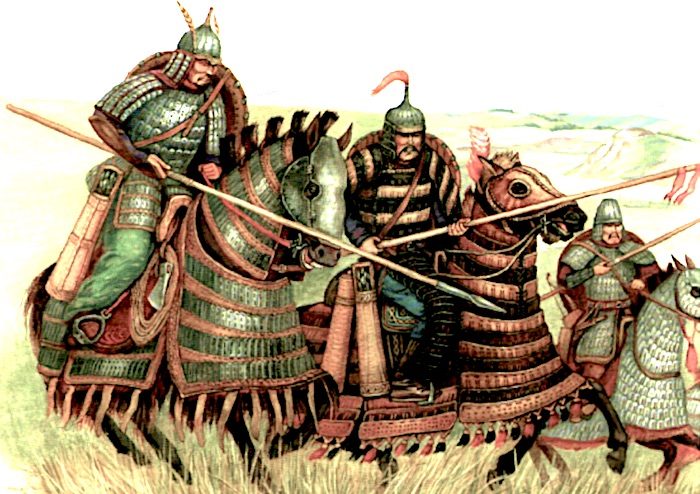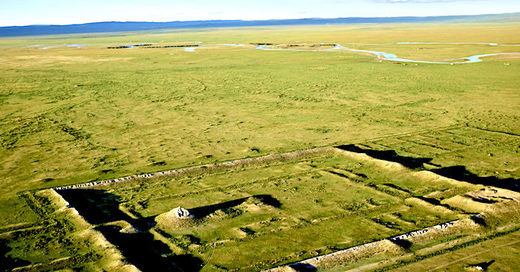
© PinterestUyghurs of the Steppe
Centuries before the Mongols took over the Eurasian steppe, the horse nomads of the Uyghur Empire responded to an epic drought through clever trade deals and unlikely alliances.
The bitterly cold, dry air of the Central Asian steppe is a boon to researchers who study the region.
The frigid climate "freeze-dries" everything, including centuries-old trees that once grew on lava flows in Mongolia's Orkhon Valley. A
recent study of the tree-ring record, published in March, from some of these archaic logs reveals
a drought that lasted nearly seven decades - one of the longest in a 1,700-year span of steppe history - from A.D. 783-850.
© Getty ImagesEurasian Steppe
Decades of prolonged drought would have killed much of the grass that the Orkhon Valley's domesticated horses relied upon. Yet the dominant steppe civilization of the era, an empire of Turkic horse nomads called the Uyghurs, somehow survived nearly 60 years of the drought, a period about seven times longer than the Dust Bowl that devastated the central U.S. in the 1930s.
Based on surviving Chinese and Uyghur documents from the drought years, the study's authors concluded that the
Uyghurs survived by diversifying their economy and using international diplomacy to boost trade. Rather than driving the Uyghurs to plunder neighboring territories - as other steppe empires tended to do -
the drought led them to take advantage of their location on the Silk Road and reinvent their economy. The Uyghurs' relatively peaceful strategies seem to have staved off total collapse for a surprisingly long time. "They were champs," says physical geographer and study co-author Amy Hessl of West Virginia University.
Prior to this paper, no one knew that the Uyghurs faced an "epic drought," Hessl says. The recognition that they did may change the way historians interpret the social, political, and economic strategies of the Uyghurs.
Instead of clashing with the Chinese Empire to their south, the Uyghurs forged a durable but uneasy alliance with the Tang dynasty in China, a rare feat for a steppe empire. The Uyghurs traded their surplus horses with the Chinese in exchange for silk. They then traded that silk with merchant allies in the fertile lands to their west.
"The fact that they had access to a precious and unique commodity might have helped them shore up their economy against the downturn of the drought," explains the study's lead author, historian Nicola Di Cosmo of the Institute for Advanced Study in Princeton, New Jersey.
The Uyghurs' tenuous alliance with the Tang dynasty wasn't the only trait that set them apart from other steppe empires.
"They were really innovators of how to run a state on the steppe," says landscape archaeologist Joshua Wright of the University of Aberdeen, who was not involved in the study.
"The Uyghurs were the first people who really built big, major cities [on the steppe]."The Uyghurs constructed at least three permanent fortress cities, including a capital that took up about 20 square kilometers.
These cities would have served as Silk Road trading hubs.Their international focus was also reflected in Uyghur leaders' conversion to
Manichaeism - a faith that saw the human soul's internal struggle as a microcosm of an ancient cosmic clash between light and dark - as the official state religion, a conversion likely influenced by foreign merchants at the Uyghur court.
The Uyghurs' reinvention of what it meant to be a steppe empire didn't end there. Archaeological evidence suggests
the Uyghurs may have been experimenting with farming during the drought, an activity seemingly at odds with their otherwise nomadic lifestyle.
Archaeologist Stefani Crabtree of Pennsylvania State University, who was not part of the study, wasn't surprised that the Uyghurs used trade and diplomacy to support themselves during the drought. "People in the past were highly connected. They had rich social lives and very large social networks," which is illustrated in the new study, Crabtree says.
Crabtree points out that societies in the U.S. Southwest also likely
used existing trade networks to sustain themselves during long dry spells. And these networks also spanned thousands of miles. For example, medieval pottery with
traces of chocolate inside found in Chaco Canyon, in what is now New Mexico, shows that Chaco was part of a trade network that reached to the tropics, where cacao beans grow. These trade networks would have existed during wet periods as well, but it's likely that trade could have helped offset food shortages. In some ways, the Uyghurs' response to the drought on the steppe may have been the rule, not the exception.
Despite their resilience to the arid climate, the Uyghur Empire's later years were plagued by bloody infighting at the royal court and attacks from their northern neighbors, the Kirghiz.
An especially brutal winter in A.D. 839-840, combined with a Kirghiz invasion, political instability, and whatever damage the long drought had inflicted, caused the empire to collapse in A.D. 840. "What we see in the history of the Uyghur[s] ... is that
drought did not necessarily create a drive for expansion or outward aggression. But it did [eventually] create massive numbers of refugees," Hessl says. One group of refugees resettled in the Tarim Basin in the modern-day Xinjiang region in China, where some of their descendants still live today - albeit not as nomads.
Though often overshadowed by the Mongols, the Uyghurs were key players on the Silk Road. "We have not as historians been very good at explaining how important these nomadic, pastoral people were in general world history, as the people who facilitated contacts and trade and connections and cultural exchange and all of that between western Asia, even Europe, and China," says Di Cosmo. "I think these people have been very much underestimated in terms of the role they played in world history."
Reader Comments